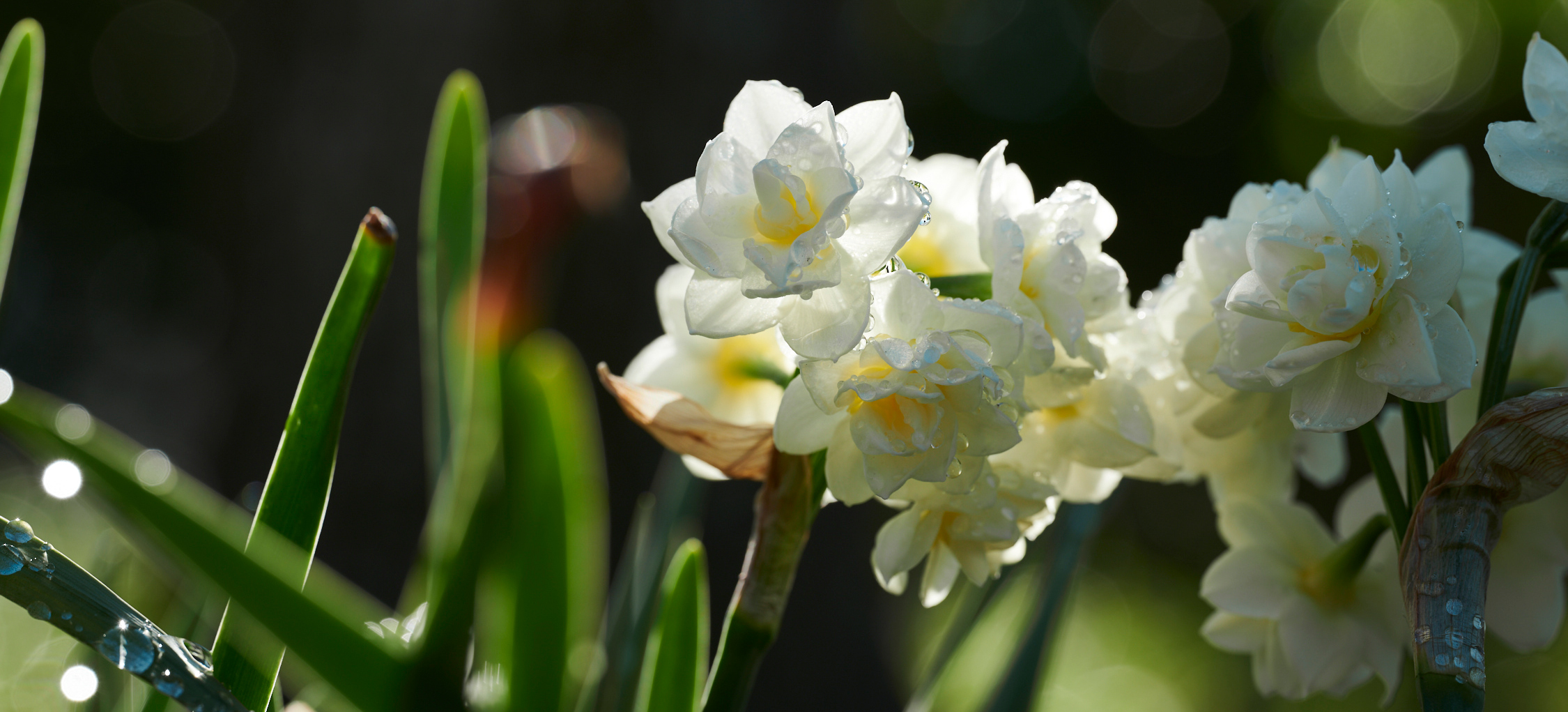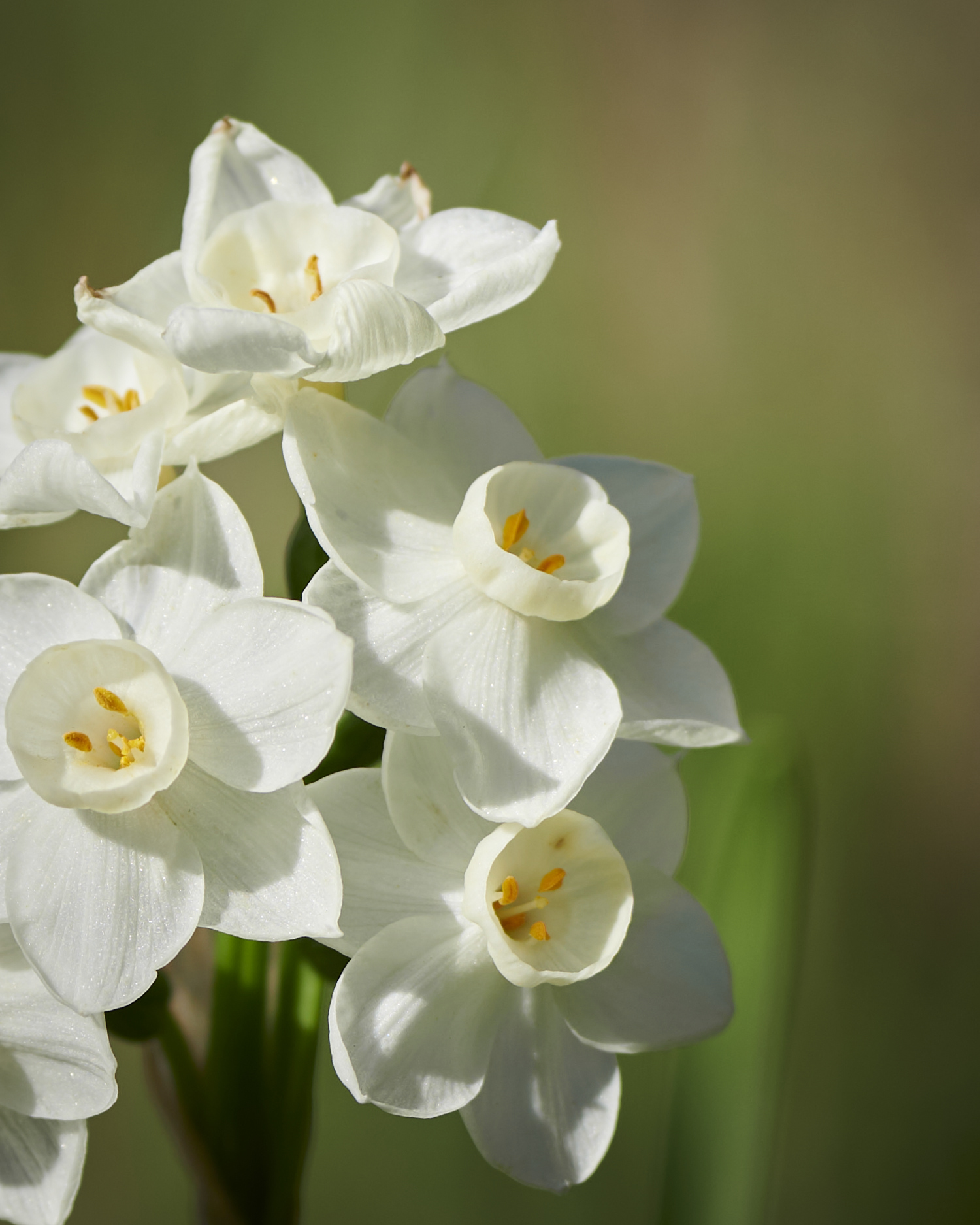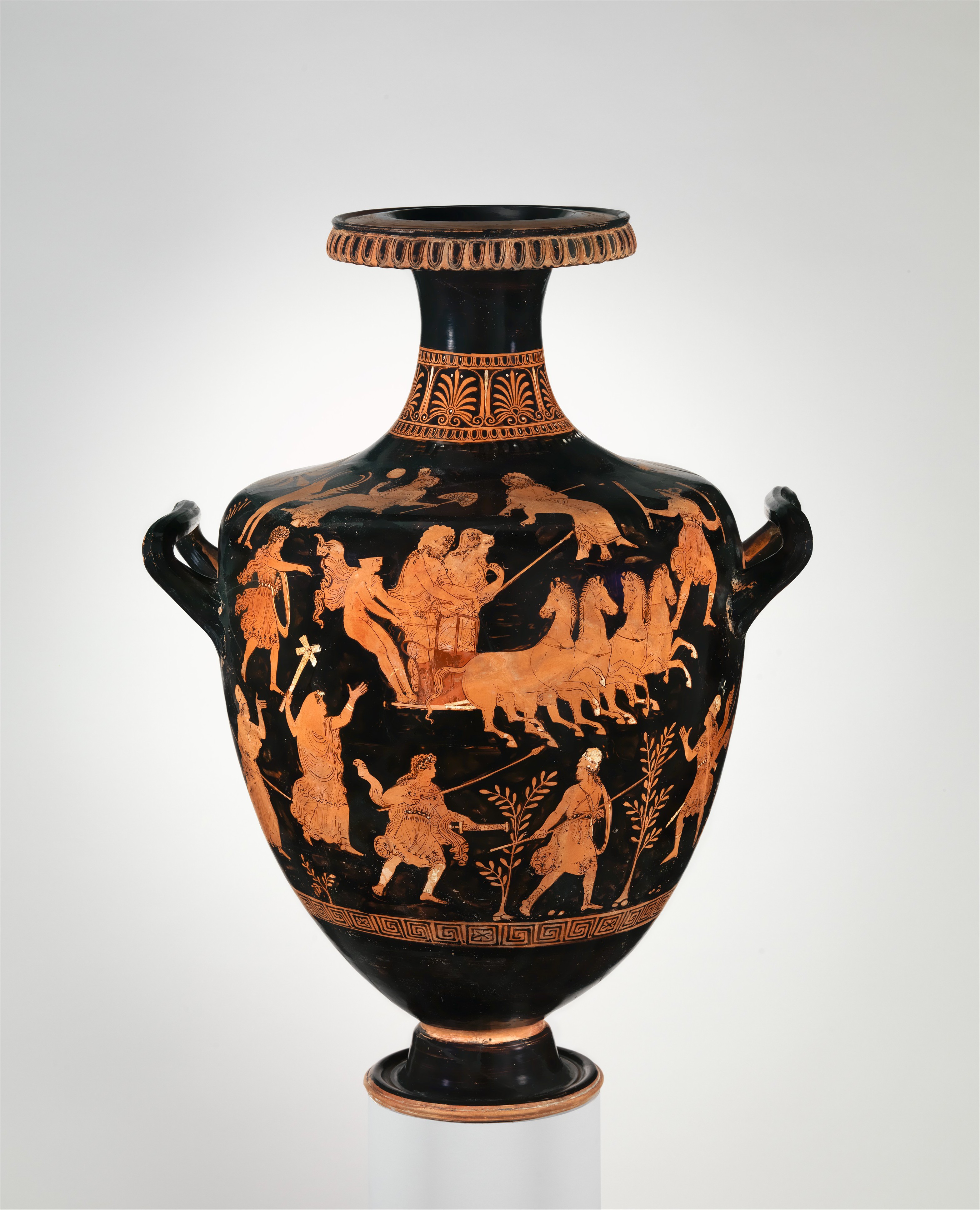Viriditas: Musings on Magical Plants
Narcissus spp.
Originally published in Issue 33 of Plantings: The Journal of the World Sensorium/Conservancy

I smell them before I see them, like the breath of ghosts floating on the breeze. Their scent is richly indolic. It lays languid in my head with a strange sweetness that oscillates between floral and foul. Emerging in early spring from their underworld sleep, they call to us, their luminous star-shaped flowers glowing in the sunlight. Narcissus is utterly hypnotic—and entirely poisonous. Associated with both death and rebirth, narcissus is a psychopomp plant that we humans have been guided by since ancient times.
The etymological root of the Greek word Νάρκισσος (Nárkissos) is “ναρκ- (nark-), meaning ‘stiff, numb,’ ‘grow numb, stiff, dead.’”1 And as Pliny the Elder clears up, Narcissus spp. “received its name, from ‘narce,’ [Latin for torpor or numbness] and not from the youth Narcissus, mentioned in the fable.”2 Hailing from Europe and northern Africa, the genus Narcissus holds around 40 species. These bulbiferous perennials have bold blooms consisting of a central corona surrounded by six tepals. Ranging from bright white to shades of yellow, peachy pink, and even green, their distinct flowers crown tall graceful stems surrounded by long linear leaves. Though not all Narcissus species are fragrant, all are poisonous and their onion-like bulb is the most toxic part. Yet the bulb, a reminder of cyclic time, is where their potent magic and poetic symbolism lies.

Flowers wilt, leaves wither, roots shrivel. Narcissus appears to die. But underground, protected deep within the bulb, the next cycle of life is brewing. As winter subsides, new roots form and young green shoots begin their journey toward the light. Narcissus is reborn. Invoking this symbolism, narcissus has long been used in death rituals. In Egyptian tombs, the bulbs have been discovered positioned on the neck and hands of mummies.3 The Greeks knew narcissus as the crown of the great ancient goddesses and placed them on the heads of the dead.4 And still today, narcissus cultivars thrive in cemeteries, silently spreading between the tombstones year after year.
Narcissus is of particular significance to the chthonic and agricultural goddess Persephone. In the Homeric Hymn to Demeter, Gaia grows narcissus as a lure for Demeter’s daughter, Persephone-Kore:5
It [the narcissus] was a wondrous thing in its splendor. To look at it gives a sense of holy awe
to the immortal gods as well as mortal humans.
It has a hundred heads growing from the root up.
Its sweet fragrance spread over the wide skies up above.
And the earth below smiled back in all its radiance. So too the churning mass of the salty sea.
She [Persephone] was filled with a sense of wonder, and she reached out with both hands
to take hold of the pretty plaything. And the earth, full of roads leading every which way, opened up under her.
It happened on the Plain of Nysa. There it was that the Lord who receives many guests made his lunge.
He was riding on a chariot drawn by immortal horses. The son of Kronos. The one known by many names.
He seized her against her will, put her on his golden chariot,
And drove away as she wept.6
In the hymn, Persephone’s communion with narcissus opens a portal to the land of the dead and sparks her initiation and transformation from maiden to queen of the underworld. The myth of her abduction by Hades, subsequent subterranean journey, and cyclical resurfacing embodies the seasonal life cycle of the natural world, especially vegetation.
Upon her daughter’s return from Hades, the hymn also details Demeter’s creation of the Eleusinian Mysteries, secret initiation rituals for the cult of Demeter and Persephone. The punishment for revealing the mysteries to the uninitiated was death, so we know very little about what occurred. Though it is generally accepted that each year, initiates re-enacted Persephone’s mythical descent and emergence from the underworld in an ecstatic spiritual experience that involved drinking sanctified kykeon, witnessing a very bright light, and often losing the fear of death. According to Cicero, the mysteries show how to “live in joy, and how to die in better hopes” (De Legibus 2.14.36).7 Ultimately, it is the alluring power of narcissus that leads to the revelation of the mysteries of life and death.
Regarded as cleansing, drying, and narcotic, the mundane powers of Narcissus spp. were also well known. The early physician Dioscorides tells us that ingesting the bulb induces vomiting, but when beaten with honey and applied topically, it is beneficial for burns and joint pain. While Narcissus flower oil is “good for damage in the vulva, softening hardness and closures around it.”8 Similarly, Pliny the Elder warns that Narcissus “is injurious to the stomach” and acts as both an emetic and a purgative that produces “dull, heavy pains in the head.”9 He also prescribes Narcissus for deep ulcers and tumors. Ibn-Sina shares their assessments and adds that Narcissus affects the nerves.10 Recent scientific research has shown that Narcissus spp. contain powerful toxic alkaloids that protect the plant and have strong effects on the human body. These bioactive compounds are antitumor, antiviral, analgesic, and tranquilizing. They have demonstrated pronounced effects on the nervous system and their alkaloid Galantamine is presently used in the treatment of Alzheimer’s patients.11 Intriguingly, Galantamine also stimulates lucid dreaming.12

Through the lens of magic, narcissus facilitates communication with the dead and the simple act of inhaling their perfume is a gentle way to work with them. Olfaction has long been used in occult practice as a portal to shift into altered states of consciousness. Scent permeates the thresholds that seemingly separate mundane experiences from the extraordinary—a process which is mirrored in our bodies on a physiological level. Olfaction is our oldest phylogenetic sensation and is uniquely able to trigger unconscious biological, physiological, and emotional responses. In this process, scent molecules bind to the tissue in our olfactory bulbs, which lead directly to our limbic system. Taken together, this is the shortest and most direct pathway physically linking our sensory perception with our surroundings. Put plainly, scent lifts the veil.
I like to place a vase of Narcissus flowers on my altar as an offering to the ancestors, though they are supportive for any work involving the underworld, threshold crossings, dreams, and moving through grief. Narcissus spp. do not, however, play nicely with other flowers. They secrete a mucilage that causes wilting and death. If you must incorporate them with other cut blooms, you can greatly reduce this mucilage by placing them in a separate container of water for a few hours beforehand. I personally translate this biological behavior as a clear communication of their preferences, so I choose to work with them on their own. It is worth noting that because of their association with the dead, some traditions consider white Narcissus inauspicious omens that should never be brought indoors.13
It’s important to use caution when working with Narcissus spp. Even handling the flowers with bare hands may cause contact dermatitis. To avoid opening an unexpected hell mouth, consider gloves—and always ask Narcissus for permission before harvesting.

1 Ann Suter, Narcissus and the Pomegranate: An Archaeology of the Homeric Hymn to Demeter (Ann Arbor: University of Michigan Press, 2002), p. 56.
2 Pliny the Elder, The Natural History of Pliny, trans. by John Bostock and H.T. Riley (London: Taylor and Francis, 1855) Book XXI ch. 75, https://www.gutenberg.org/files/57493/57493-h/57493-h.htm
3 Krzysztof Borysławski, Anna Niwińska, Andrzej Niwiński, Agnieszka Tomaszewska, Krystyna Wasylikowa, Agnieszka Zelazniewicz, “A Bulb of Narcissus on the Egyptian Mummy from University of Wrocław Collection,” Études et Travaux (Dec 2018): 111-22, https://doi.org/10.12775/EtudTrav.31.006.
4 Sophocles, Oedipus at Colonus, ed. with introduction and notes by Sir Richard Jebb (Cambridge: Cambridge University Press, 1889) lines 681-684. Perseus Digital Library.
5 According to Dr. Safron Rossi, the Kore epithet associated with Persephone, signifies the state of sovereignty and wholeness in oneself. See Rossi, The Kore Goddess: A Mythology & Psychology, 2021.
6 Homeric Hymn to Demeter, trans. by Gregory Nagy, lines 10–20, https://chs.harvard.edu/primary-source/homeric-hymn-to-demeter-sb/
7 Helene P. Foley, ed. The Homeric Hymn to Demeter: Translation, Commentary, and Interpretive Essays, STU-Student Edition, (Princeton: Princeton University Press, 1994) 71.
8 Dioscorides Pedanius, T. A. Osbaldeston, and R. P. A. Wood, De Materia Medica: Being an Herbal with Many Other Medicinal Materials: Written in Greek in the First Century of the Common Era: a New Indexed Version in Modern English (Johannesburg: IBIDIS, 2000), 63 and 716.
9 Pliny the Elder, The Natural History of Pliny, John Bostock and H.T. Riley, trans, (London: Taylor and Francis, 1855) Book XXI ch. 75, http://www.perseus.tufts.edu/hopper/text?doc=urn:cts:latinLit:phi0978.phi001.perseus-eng1
10 Ibn-Sina, Canon of Medicine Book II: Materia Medica, trans. Department of Islamic Studies Hamdard University (New Dheli: Jamia Hamdard Printing Press, 1998), Sec. II, 453-4, https://www.naimh.com/_files/ugd/ee530d_32edca193e5e4e039a0a2e27171c2a65.pdf.
11 Jaume Bastida, et al. “Chemical and biological aspects of Narcissus alkaloids.” The Alkaloids. Chemistry and Biology (vol. 63, 2006), 87-179. doi:10.1016/s1099-4831(06)63003-4
12 Stephen LaBerge, et al. “Pre-sleep treatment with galantamine stimulates lucid dreaming: A double-blind, placebo-controlled, crossover study.” PloS One, vol. 13, (8 Aug. 2018), doi:10.1371/journal.pone.0201246.
13 Marcel De Cleene and Marie Claire Lejeune, Compendium of Symbolic and Ritual Plants in Europe, Vol. II: Herbs (Ghent: Man & Culture Publishers, 2003) p. 212. .

